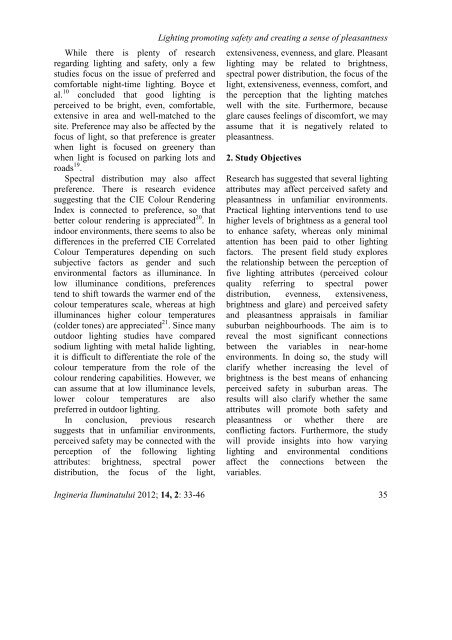Untitled - Journal of Lighting Engineering
Untitled - Journal of Lighting Engineering
Untitled - Journal of Lighting Engineering
You also want an ePaper? Increase the reach of your titles
YUMPU automatically turns print PDFs into web optimized ePapers that Google loves.
While there is plenty <strong>of</strong> research<br />
regarding lighting and safety, only a few<br />
studies focus on the issue <strong>of</strong> preferred and<br />
comfortable night-time lighting. Boyce et<br />
al. 10 concluded that good lighting is<br />
perceived to be bright, even, comfortable,<br />
extensive in area and well-matched to the<br />
site. Preference may also be affected by the<br />
focus <strong>of</strong> light, so that preference is greater<br />
when light is focused on greenery than<br />
when light is focused on parking lots and<br />
roads 19 .<br />
Spectral distribution may also affect<br />
preference. There is research evidence<br />
suggesting that the CIE Colour Rendering<br />
Index is connected to preference, so that<br />
better colour rendering is appreciated 20 . In<br />
indoor environments, there seems to also be<br />
differences in the preferred CIE Correlated<br />
Colour Temperatures depending on such<br />
subjective factors as gender and such<br />
environmental factors as illuminance. In<br />
low illuminance conditions, preferences<br />
tend to shift towards the warmer end <strong>of</strong> the<br />
colour temperatures scale, whereas at high<br />
illuminances higher colour temperatures<br />
(colder tones) are appreciated 21 . Since many<br />
outdoor lighting studies have compared<br />
sodium lighting with metal halide lighting,<br />
it is difficult to differentiate the role <strong>of</strong> the<br />
colour temperature from the role <strong>of</strong> the<br />
colour rendering capabilities. However, we<br />
can assume that at low illuminance levels,<br />
lower colour temperatures are also<br />
preferred in outdoor lighting.<br />
In conclusion, previous research<br />
suggests that in unfamiliar environments,<br />
perceived safety may be connected with the<br />
perception <strong>of</strong> the following lighting<br />
attributes: brightness, spectral power<br />
distribution, the focus <strong>of</strong> the light,<br />
<strong>Lighting</strong> promoting safety and creating a sense <strong>of</strong> pleasantness<br />
extensiveness, evenness, and glare. Pleasant<br />
lighting may be related to brightness,<br />
spectral power distribution, the focus <strong>of</strong> the<br />
light, extensiveness, evenness, comfort, and<br />
the perception that the lighting matches<br />
well with the site. Furthermore, because<br />
glare causes feelings <strong>of</strong> discomfort, we may<br />
assume that it is negatively related to<br />
pleasantness.<br />
2. Study Objectives<br />
Research has suggested that several lighting<br />
attributes may affect perceived safety and<br />
pleasantness in unfamiliar environments.<br />
Practical lighting interventions tend to use<br />
higher levels <strong>of</strong> brightness as a general tool<br />
to enhance safety, whereas only minimal<br />
attention has been paid to other lighting<br />
factors. The present field study explores<br />
the relationship between the perception <strong>of</strong><br />
five lighting attributes (perceived colour<br />
quality referring to spectral power<br />
distribution, evenness, extensiveness,<br />
brightness and glare) and perceived safety<br />
and pleasantness appraisals in familiar<br />
suburban neighbourhoods. The aim is to<br />
reveal the most significant connections<br />
between the variables in near-home<br />
environments. In doing so, the study will<br />
clarify whether increasing the level <strong>of</strong><br />
brightness is the best means <strong>of</strong> enhancing<br />
perceived safety in suburban areas. The<br />
results will also clarify whether the same<br />
attributes will promote both safety and<br />
pleasantness or whether there are<br />
conflicting factors. Furthermore, the study<br />
will provide insights into how varying<br />
lighting and environmental conditions<br />
affect the connections between the<br />
variables.<br />
Ingineria Iluminatului 2012; 14, 2: 33-46 35
















